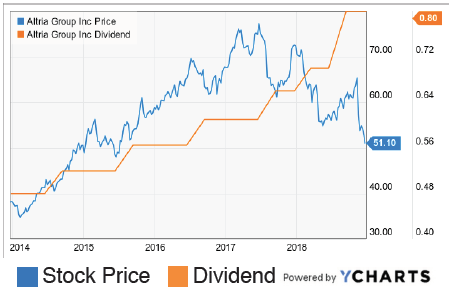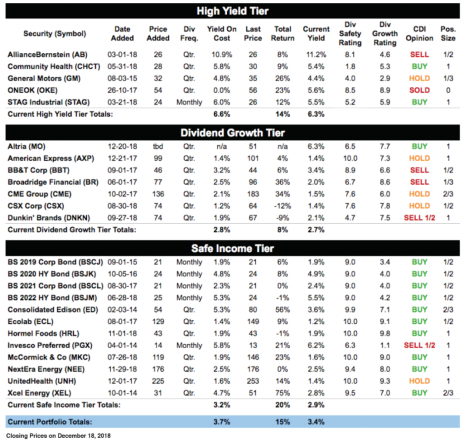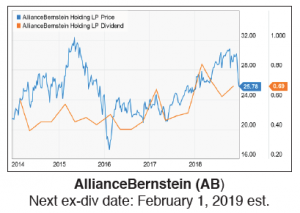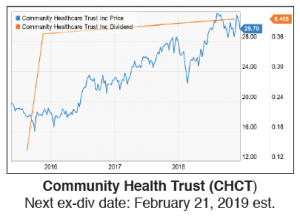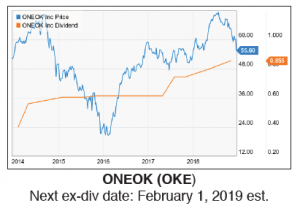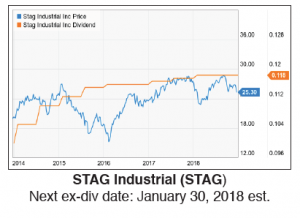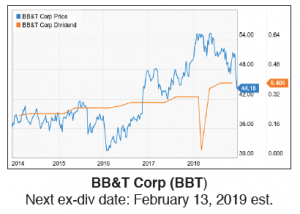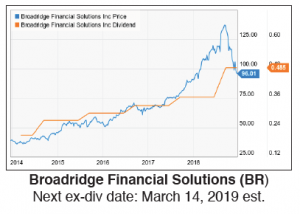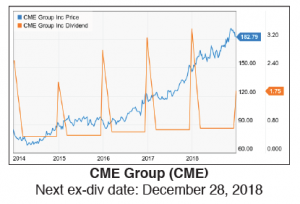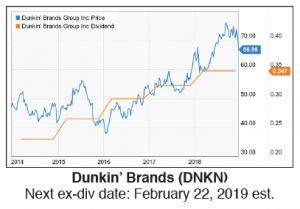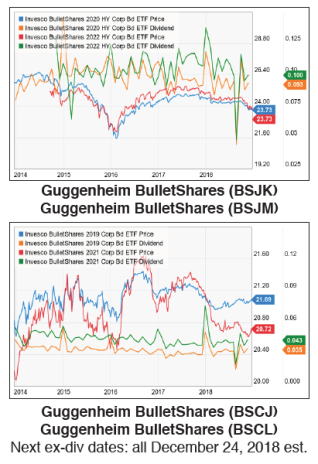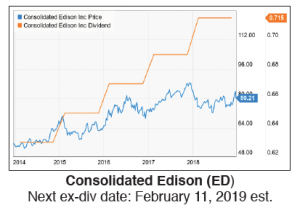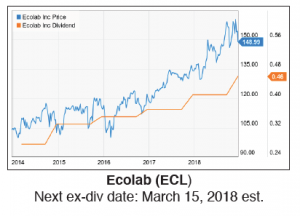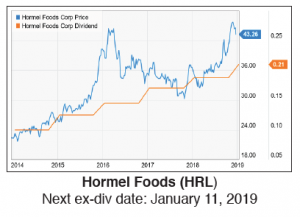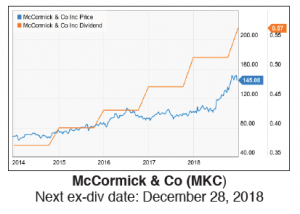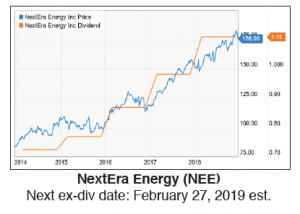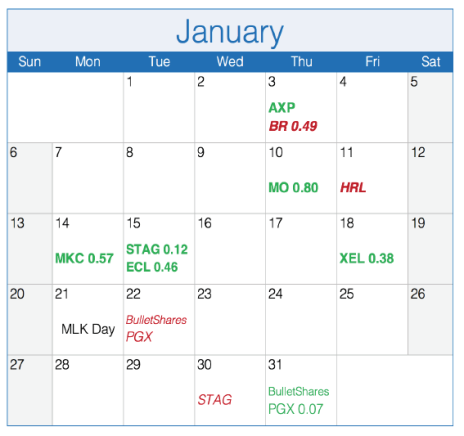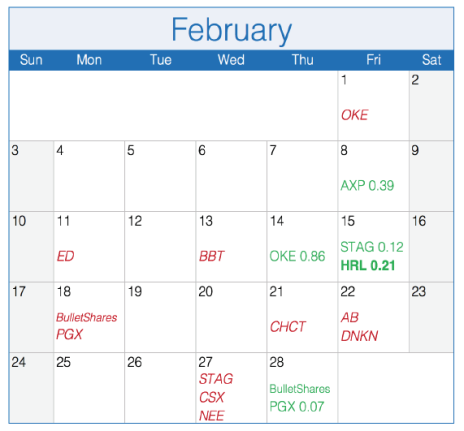I launched Cabot Dividend Investor five years ago to help investors like you build a balanced portfolio of reliable dividend-paying stocks. It’s been a great journey, and I hope you’ve learned a lot and have made some money.
Cabot Dividend Investor isn’t going anywhere, but it’s time for me to move on. I’m excited to pursue new opportunities in the New Year, and I’ll be leaving you in great hands. Tom Hutchinson, the new Chief Analyst of Cabot Dividend Investor, will introduce himself in this month’s issue, with his take on the market and an exciting new stock pick.
But before I turn everything over to Tom, I’m going to wrap up a few loose ends in the portfolio—some things have unraveled a bit over the past month.
Cabot Dividend Investor 1218
[premium_html_toc post_id="166616"]
Should I Stay or Should I Go?
by Tom Hutchinson
My name is Tom Hutchinson. Starting next month I will be taking over as Chief Analyst of Cabot Dividend Investor. I’m excited to share the fruits of my life’s work and passion by giving you investments and strategies that will provide you a reliable cash flow and grow your money at the same time. I will introduce myself more fully in the future, but for now, it’s more urgent to address the current treacherous market situation.
Let’s face it. This market is ugly. And it’s unlikely that the selling is over. All three major indexes have been trending down since the beginning of October. The downtrend has involved a technically ominous series of lower highs and lower lows. All the indexes have fallen to a 10% correction already and the market is showing no signs of turning around.
Is this a buying opportunity or the early stages of a bear market? Should you get out of the market or look for bargains?
It’s difficult to see this as a bear market (down 20% or more from the high) because there is no sign of recession. Sure, the economy will probably slow down from the torrid growth of the last two quarters. But the economy is a long way from contraction, which typically follows a bull market. Thus I believe the market will regain its composure and trend higher in the first half of next year. However, it’s still too early to get aggressive; the market will probably get worse before it gets better.
Defensive companies are the best place to be right now. But the best REITs and utilities have already been thriving and are near 52-week highs. It’s unwise to get in now, toward the end of this phase. Fortunately, I found a stock that is defensive and also near its 52-week low. It pays a stellar 6% yield and should have little downside from here.
This month’s Featured Buy has been one of the best down-market performers of all time but also has upside potential when the market turns around. The stock thus currently offers something rarely found, the ability to be opportunistic and at the same time play defense.
Featured Buy
by Tom Hutchinson
Altria Group (MO)
Altria Group (MO) is the largest US domestic cigarette maker and one of the largest in the world. The company is the domestic part of the old Philip Morris that spun off the international division in the form of Philip Morris International (PM) in 2008. Altria now operates primarily in the United States.
In addition to cigarettes, Altria also sells cigars, beer, wine, smokeless products and e-vapor though its subsidiaries U.S. Smokeless Tobacco, John Middleton, Ste. Michelle Wine Estates and e-vapor company Nu Mark. Altria also owns a 10.2% stake in the world’s largest brewer, Anheuser-Busch InBev (BUD).
It may seem like a diversified company but it isn’t. About 85% of net revenues are generated from cigarettes and the overwhelming majority of that is from its flagship Marlboro brand, which commands a stratospheric 40% cigarette market share in the U.S. You could really just consider Altria to be the Marlboro company.
On the surface that’s a bit of a problem. In case you haven’t heard, cigarettes are bad for you. The number of smokers in the U.S. is shrinking by about 3% to 4% per year and has been for quite some time. Isn’t it a bad idea to invest in a company that operates in a receding business?
The Amazing Track Record
Not in this case. The fact is that in addition to generating obscene amounts of cash by selling addictive products, Altria has been able to offset the shrinkage in smoker volume by raising prices on its dominant Marlboro brand, by growing its ancillary businesses and by aggressively buying back shares, which boosts earnings per share. Per share earnings have grown by an average of 11.08% per year for the last five years. Consider the stock performance.
Prior to the company’s split in 2008, MO had been one of the best performing S&P 500 stocks ever; the stock is in the top 1% of S&P 500 performance for the past 10, 20 and 30 year periods. The dividend has also been raised for 49 consecutive years.
If you bought MO after the split ten years ago on 12/15/2008 and reinvested the dividends, you would have made a total return of 489%—the equivalent of an annual average return of 19.42%. A $10,000 investment would now be worth $58,960. That’s like buying a house ten years ago for $200,000 that’s now worth $1.18 million, without putting a dime into it. (The numbers were even more impressive before the stock’s recent struggles.)
An Uncharacteristically Awful Year
Altria is no stranger to regulations and lawsuits; such challenges have been a constant at the company for many decades. But this year the regulators have gotten more aggressive. The agency put restrictions on flavored electronic cigarettes and has threatened to outlaw menthol cigarettes. The e-cig issue isn’t a big deal but banning menthol is, as menthol cigarettes account for about 20% of Altria’s profits.
This is the most aggressive the FDA has been in nearly a decade and the market didn’t like it. The result is likely to be years of court battles before a ban can be enforced and by then Altria will likely compensate for the loss, as they have historically done so well. Nevertheless, Morningstar’s Tobacco group is off 29% year-to-date and Altria is down over 21%, marking a rare blip in Altria’s remarkably consistent performance.
The Opportunity
Tobacco stocks and MO in particular have historically been some of the most resilient stocks in times of recession and bear markets. The recent price decline, which has the stock selling near a five-year low, should give MO even less downside risk than usual. At the current beaten-down price with recent dividend hikes (21.2% over the last two years), the legendary stock now yields a staggering 6%.
And there’s something else.
Early this month, Altria jumped into the cannabis (marijuana) market by purchasing a 45% stake in Canadian cannabis company Cronos Group (CRON) for $1.8 billion, with an option to increase the stake to 55% over the next five years. Cronos is one of the leading companies in this young market, with third quarter revenues of $3.8 million—up 186% from the year before—and operations on five continents.
This provides Altria a huge growth component that it didn’t have through the aforementioned five-year track record. With its deep pockets and unparalleled production capability and regulatory expertise, Altria is likely to be a powerful partner for Cronos.
The global cannabis market is forecast to grow by about 35% per year through 2025—but it could be even bigger. Canada is the only developed nation to approve recreational marijuana but others will likely follow—and eventually the U.S., where nine U.S. states have already legalized it.
With its track record, battered stock price, sky-high dividend, and historic bear market performance; Altria is an ideal stock to buy here. But with the newly added growth element from cannabis it could turn out to be the income investment of a lifetime.
| Altria Group (MO) | ||
|---|---|---|
| Price: 50.89 52-week range: 50.69-73.25 Market cap: $95.87 billion P/E: 9 | Current yield: 6.1% Annual dividend: $3.20 Most recent dividend: $0.80 Dividend Safety rating: 6.5 Dividend Growth rating: 7.7 | |
| Dividends since: 2008 Consecutive years of increases: 9 Qualified dividends? Yes | Payment Schedule: Quarterly Next ex-dividend date: December 24, 2018 | |
Portfolio at a Glance
Portfolio Updates
High Yield Tier
The investments in our High Yield tier have been chosen for their high current payouts. These ?investments will often be riskier or have less capital appreciation potential than those in our other ?two tiers, but they’re appropriate for investors who want to generate maximum income from their? portfolios right now.
SELL – AllianceBernstein (AB 26 – yield 11.2%) – This week’s pullback brought AB to new six-month lows, and it’s time to part with the high-yielding asset manager. After plummeting through its 200-day moving average on high volume two weeks ago, the stock continued to sink, falling 12% at one point. Even if yesterday’s bounce marked an intermediate-term bottom, the damage done over the past two weeks is not insignificant, and I don’t think AB will be the best place to be even once the market recovers. I already sold half our position at last Wednesday’s average price, and I’m going to sell the rest of our shares today. Sell.
BUY – Community Health Trust (CHCT 30 – yield 5.4%) – Community Health Trust is a REIT that owns health care buildings in non-urban areas. I put CHCT back on Buy last week, impressed by the REIT’s resilience as the market deteriorated. The stock then pulled back to start this week, but found support at its 200-day line yesterday, and I think this is a good buying opportunity. REITs have shown little inclination to participate in the correction of the past three months, instead looking forward to the gradual normalization of interest rates next year. Buy cautiously.
HOLD – General Motors (GM 35 – yield 4.4%) – GM has held up well over the past week, trading just above its 50-day line, currently around 35. The stock doesn’t have much momentum, but no one is running for the exits either, which is a good sign these days. The stock is volatile though—Trump’s trade war continues, the President’s Twitter attacks on the company are unpredictable, and news about the company’s job cuts continues to develop. But long-term investors are looking forward to the company’s self-driving and ride-sharing investments starting to pay off next year. Risk-tolerant investors primarily interested in yield and long-term gains can continue to Hold.
SOLD – ONEOK (OKE 56 – yield 5.6%) – I sold the final third of our ONEOK shares last week, at Wednesday’s average price of 59.78. Our total return on the investment, which we made in October 2017, was 23%. The natural gas processing and transport company pays reliable dividends, but the stock has gotten caught in a persistent downtrend as oil prices continue to fall, dragging down all energy stocks. I recommend all investors sell now, and redeploy the profits into something safer, or hang on to them until the market becomes more constructive.
BUY – STAG Industrial (STAG 26 – yield 5.5%) – STAG retested its October low this week, but is still within its three-month trading range. The monthly dividend payer has been a good store of value and source of income during the last two months, and I’m going to keep it tentatively on Buy. STAG is an industrial REIT that owns properties in 37 states that are mostly used as warehouses and fulfillment centers. Major tenants include the Federal government and logistics companies.
Dividend Growth Tier
To be chosen for the Dividend Growth tier, investments must have a strong history of dividend increases and indicate both good potential for and high prioritization of continued dividend growth.
HOLD – American Express (AXP 101 – yield 1.4%) – AXP continues to pull back, and the stock dropped through its 200-day line during Monday’s selloff. But AXP has found support at the moving average several times this year, sometimes after closing below it a couple times, so as long as it doesn’t decline much further, and bounces back soon, I think you can hold on. AXP is performing much better than a lot of other financial stocks, and its relative strength is a good sign. Hold.
SELL – BB&T Corp (BBT 44 – yield 3.4%) – BBT looks like a lost cause. The stock has been sliding since the start of the month, and is now hitting 52-week lows on a daily basis. Volume isn’t elevated, but that’s about the only positive. On top of the overall weakness in financial stocks, Morgan Stanley recently published an analyst report arguing that bank stocks will struggle next year due to deterioration in the credit market and a plateau in interest rates. It’s a big macro prediction that may or may not come true, but it doesn’t matter; the stock’s action is telling me all I need to know right now. I’m going to Sell the rest of our BBT shares today.
SELL – Broadridge Financial Solutions (BR 96 – yield 2.0%) – I’m also going to let BR go this week, the stock’s downward march has continued. Broadridge provides investor communication solutions and other technology to financial companies and was a profitable investment for us until the stock’s uptrend ended in September. We already sold one third of our shares in August for a 47% profit, and another third in November for a 30% profit. After selling the rest today, we’ll probably record a total return of 36%. Take your profits and put them somewhere safe.
HOLD – CME Group (CME 183 – yield 1.5%) – CME runs financial exchanges where traders buy and sell derivatives on everything from equity indexes to interest rates, and revenues rise when market volatility picks up, so the stock has been doing very well since the current correction started in October. After hitting a new 52-week high in mid-November, CME spent the past three weeks consolidating. However, the stock just crossed its 50-day moving average to the downside yesterday, so I’m going to put it on Hold today—hopefully just for a moment. The company regularly distributes excess cash flow to investors at the end of the year, and will pay a special end-of-year distribution of $1.75 per share this year. (The company’s regular quarterly dividends total $2.80 per year.)
HOLD – CSX Corp. (CSX 64 – yield 1.4%) – CSX is re-testing its October lows, but this time the pullback has brought the stock below its 200-day line, where it has closed for three days in a row. That’s a red flag, so if you haven’t already reduced risk by selling some shares, consider doing so now (I already sold half our shares in October, for a 10% loss). I’ll keep CSX on Hold for now; if the stock finds support here it could be worth holding on to. On the other hand, the stock may have hit an intermediate-term top in August—only time will tell. Hold for now.
SELL HALF – Dunkin’ Brands (DNKN 67 – yield 2.1%) – After maintaining a tight range for the first two months of the correction, DNKN has finally succumbed to the selloff, and slid through its 200-day moving average during Monday’s panic. This could be a quick and inconsequential blip on the stock’s chart, but given the lousy market environment, I think it’s smart to err on the side of caution. I’m going to reduce our risk by selling half of DNKN today, for a loss of about 9%. If the stock bounces back quickly, great. If it doesn’t, consider cutting your losses before the situations gets worse. Sell Half.
Safe Income Tier
The Safe Income tier of our portfolio holds long-term positions in high-quality stocks and other investments that generate steady income with minimal volatility and low risk. These positions are appropriate for all investors, but are meant to be held for the long term, primarily for income—don’t buy these thinking you’ll double your money in a year.
BUY – Invesco BulletShares 2019 Corporate Bond ETF (BSCJ 21 – yield 1.9%)
BUY – Invesco BulletShares 2020 High Yield Corporate Bond ETF (BSJK 24 – yield 4.9%)
BUY – Invesco BulletShares 2021 Corporate Bond ETF (BSCL 21 – yield 2.4%)
BUY – Invesco BulletShares 2022 High Yield Bond ETF (BSJM 24 – yield 5.5%)
After a prolonged drop last month, the high yield funds in our bond ladder have stabilized. However, some analysts believe weakness in junk bonds is permanent, citing increased recession risk and an end to the “reach for yield” created by low interest rates over the past decade. Low oil prices aren’t helping things either; about 15% of junk bond issuers come from the energy sector. Even if junk bonds remain out of favor, the BulletShares funds should be a fairly good store of value, since Invesco disburses the net asset value, or NAV, of the ETF back to investors at expiration. Still, if you’re looking for shorter-term security, or are very risk-averse, stick to the investment-grade rated BulletShares.
BUY – Consolidated Edison (ED 80 – yield 3.6%) – Even utilities—classic safe havens—experienced some selling this week, but I expect it’s mostly transient. The yield on the 10-year Treasury has fallen to a four-month low, and the selloff in the stock market drove ED to its highest level since January 2 last week. I expect utilities to remain in favor as long as the stock market remains dangerous, with a longer-term tailwind from anticipation of a return to neutral interest rates next year. ED can be bought on pullbacks. The company is the electricity and gas provider for New York City and the surrounding area, and is a good safe haven from market volatility and source of reliable quarterly dividends.
BUY – Ecolab (ECL 149 – yield 1.2%) – ECL has pulled back just to its 200-day moving average this week. The company is a conservative cash cow and the stock has held most of its value over the past three months. It’s dicey out there, but for now this pullback still looks buyable—just be very cautious and back off if the stock violates the 200-day line. Ecolab’s management recently increased the company’s quarterly dividend by 12%, to $0.46 per quarter, Ecolab’s 32nd consecutive annual dividend increase. The company produces cleaning chemicals and other products used in a variety of industries.
BUY – Hormel Foods (HRL 43 – yield 1.9%) – HRL also pulled back Monday after generally ignoring the correction for the past three months, a testament to just how panicky Monday’s selloff got. The stock closed below its 50-day line, although it’s still well above its 200-day. HRL was hitting new 52-week highs just a couple of weeks ago, and volume is normal. I’m going to keep the stock tentatively on Buy as a good safe haven and source of regular income. Just use common sense picking your spots. Management recently raised the stock’s dividend by 12%, Hormel’s 53rd annual dividend increase in a row.
SELL HALF – Invesco Preferred ETF (PGX 13 – yield 6.2%) – As I noted last week, PGX has been hit by a major selloff in preferred shares, tied to fears of a credit crunch or even a liquidity crisis in high yield fixed income markets. The selling has hit preferred shares, bank loans and junk bonds. Investors are moving instead into more liquid, more credit-worthy investment-grade bonds and treasuries. It’s impossible to say whether this is the beginning, middle or end of this shift. So, to reduce risk, I’m going to sell half of our shares in PGX today. Sell Half.
BUY – McCormick & Co (MKC 146 – yield 1.6%) – MKC has pulled back just to its 50-day line over the past week, the stock’s first time touching the moving average since September. MKC could consolidate for a bit here; the stock has been advancing without a significant pullback since June. But consumer staples still look like a good safe haven from the market correction, so I’ll keep MKC tentatively on Buy. McCormick makes spices as well as numerous brand-name sauces, seasonings and condiments. Management recently increased the dividend by 10%, McCormick’s 32nd consecutive annual dividend increase.
BUY – NextEra Energy (NEE 176 – yield 2.5%) – NEE was also hit by Monday’s panic selling, dropping as low as its 50-day line at 176. The utility is still a good counter-cyclical holding though, so I think this pullback is probably buyable. NextEra is the electric utility for much of Florida, plus a major producer of renewable energy. In addition to wind and solar farms, the company also owns battery storage sites, natural gas pipelines and nuclear plants. The company has paid dividends every year since 1983, and has increased the dividend every year since 2005.
HOLD – UnitedHealth Group (UNH 253 – yield 1.4%) – Health care stocks got hit hard by this week’s selloff; only the real estate index declined more over the past five days. UNH was dragged down to its 200-day line, the stock’s first time visiting the moving average in over two years. I’m going to move the stock to Hold today, and you might want to take some profits off the table if we get a bounce in the next couple of days. Analysts are still very bullish on the company after management released strong 2019 financial guidance a couple weeks ago, but the stock has become significantly more volatile in recent weeks. Hold.
BUY – Xcel Energy (XEL 51 – yield 2.8%) – XEL is pulling back with everything else this week but the stock is still shy of its 50-day line, so I’ll keep it on Buy for now. Propelled higher by investors seeking safety and anticipation of a more dovish Fed, XEL just hit a new 52-week high Friday. The company is a Minnesota-based utility with significant investments in wind farms, and is a good counter-cyclical investment and source of safe income.
Closing Prices on December 18, 2018
Dividend Calendar
Ex-Dividend Dates are in RED and italics. Dividend Payments Dates are in GREEN. Confirmed dates are in bold, all other dates are estimated. See the Guide to Cabot Dividend Investor for an explanation of how dates estimated.
Year in Review
by Chloe Lutts Jensen
From the headlines this week, you’d think 2018 was a terrible time to be an investor. Yes, the broad market is on track to end the year in the red—although it’s really too soon to say—but that makes the year sound much worse than it was! A lot happened in 2018, and it wasn’t all bad.
After a strong start to the year, the broad market did correct sharply in February, but it was over quickly. Investors largely forgot about the selloff as stocks climbed to new all-time highs over the next six months. The major indexes were all in uptrends for the entirety of the second and third quarters, and by September the news was all about the indexes hitting new all-time highs.
Of course, that all feels like ancient history now, as the correction the broad market started in October stretches into its third month. The major indexes are now lower for the year, which makes it easy to forget all the stuff that happened in the middle.
Don’t give in to the temptation. Lots happened this year, and there’s plenty to be learned from it, if you can look back further than the past two weeks (unlike most of the talking heads on TV and online). So, as has become tradition, I’d like to close this, my last Cabot Dividend Investor issue, with a look back at our year in review.
Here are a few of the lessons we learned this year.
Lesson #1: Industry Matters… Especially in Energy
Our first buy of the year was an attempt to add some energy exposure to the Safe Income tier. I recommended ExxonMobil (XOM) at the end of January, but my timing was terrible. The market had just started what turned out to be a 20% correction, and I sold the stock a month later for an 11% loss. XOM continued to decline for about four more weeks.
I gave energy stocks another go with the addition of Occidental Petroleum (OXY) to the more risk-tolerant Dividend Growth Tier at the end of June. My timing was off again and I cut our losses at 16% in October. Both XOM and OXY have fallen further since we sold them, proving once again that timing is everything with energy stocks, given how leveraged they are to oil prices.
ONEOK (OKE), which we bought last year, has also been a victim of the selloff in energy stocks. I sold a third of our shares in August for a 24% profit, before the stock was dragged down by the energy industry selloff this fall. I sold another third of our shares for a 10% profit at the end of November, and the rest last week. Energy stocks continue to remind us why it’s essential to have industry trends on your side.
Lesson #2: Uptrends Are Great… But Can End
One of the lessons I took note of last year was that our best buys were all stocks that were already in uptrends. That lesson helped lead me to UnitedHealth Group (UNH) and American Express (AXP), both of which were in uptrends when we bought them and both of which have worked out great for us (we’ve owned both all year).
However, uptrends were fickle friends in 2018. The second stock I bought this year was AllianceBernstein (AB), added to the high yield tier on the first of March. The stock trended up nicely from May to August, then dropped sharply in early August after Fidelity introduced new zero-fee mutual funds. AB recovered quickly, but struggled to break out past overhead resistance for the next four months. Then the stock got slammed by the massive selloff in financials this month—I sold half our shares last week and the rest this week.
In May I added Community Health Trust (CHCT) to the high-yield Tier; the stock had recently started a new uptrend and continued to rise for a couple months before plateauing in August. But I think the REIT might get back in gear soon though and recently put it back on Buy. I also bought CSX Corp. (CSX) at the end of August. The stock was in an uptrend when I added it to the portfolio, but may have topped out shortly after (only time will tell).
On April 25 I added McGrath RentCorp (MGRC) to the Safe Income Tier; the stock was trending up at the time but reversed course only a month later. There was no clear reason for the downtrend so I held on until our losses hit 15%, at the end of October. MGRC has bounced a bit since, so the lesson here isn’t entirely clear.
Finally, Broadridge Financial (BR) was in an incredibly stable uptrend when I added it to the portfolio last year, and continued to advance for the next fifteen months. Unfortunately that may have made me a bit too attached to the stock. I did sell a third of our shares for a 47% profit after the stock dipped below its 50-day line in August, but watched our profit shrink to 30% before taking some more profits in November, and finally selling the rest of the stock today.
Uptrends are powerful, but it’s important to be able to recognize when they’re over.
Lesson #3: Conservative Stocks Can Be Big Winners
Since the start of the fourth quarter, I’ve been keeping my new additions to the portfolio on the conservative side, and it’s worked out very well for us. I added Hormel (HRL) on November 1 and NextEra Energy (NEE) on November 29. Along with McCormick & Co. (MKC), which I added to the Safe Income tier at the end of July, and the two utilities we’ve owned since 2014 (XEL and ED), these conservative picks have helped our portfolio perform better than average during the recent market correction. Boring stocks don’t have to be boring.
Lesson #4: Partial Profits Still Work
One of the biggest lessons I took away from my 2016 review was that selling some shares when a stock started to weaken was a good way to preserve profits and reduce risk. I put that lesson to good use in 2017, and again in 2018.
In April I sold 3M (MMM) in three tranches, for a total return of about 10%, and in May I sold Cummins (CMI) for about breakeven. You can read more about those two trades, and why I believe they make a good argument for taking partial profits, in June’s educational article. Both stocks are lower since we sold.
I sold a third of our General Motors (GM) shares March 28, for a 12% profit. The stock has been volatile and chopped around since, so I don’t regret reducing our risk, although I’m still optimistic long-term. I sold half our shares in BB&T Corp. (BBT) when the stock fell to a new six-month low after reporting earnings in July. The sale generated a profit of 9.5% on price only, protecting some of our profits from the stock’s further declines this quarter.
Finally, in May I sold a third of our shares in CME Group (CME) for an 18% profit. We’ve owned the stock since October 2017 but it had been consolidating for a few months by that point. The stock spent a few more months trading sideways before starting a new uptrend in August.
Lesson #5: Know When To Say Goodbye
Partial sales can be useful, but it’s also important to know when to simply cut a stock loose.
At the end of February I sold the final third of our Wynn Resorts (WYNN) shares, for a total return of 61%. The stock’s future was uncertain, in the face of investigations by gaming boards in Nevada, Massachusetts and Macau, and the impact of Steve Wynn’s resignation. The stock has dropped 37% since we sold, so it was definitely the right call.
I also sold the rest of our Carnival Corporation (CCL) after the stock gapped down to a new 52-week low in June. That turned out to be the right call; the stock spent most of the next six months below that level. Our total return was 34%, so I’m not complaining, but we could have sold even earlier. I noted at the time that the stock had been trending down since the end of January and had been below its 50-day line since the end of February.
I hope you’ve learned as much as a Cabot Dividend Investor subscriber as I have as Chief Analyst. I wish you and Tom best of luck this year and in the future. Never stop learning.
[premium_html_footer]
Your next issue will be published January 30, 2019
Cabot Wealth Network • 176 North Street • Salem MA 01970 • 978-745-5532
Neither Cabot Wealth Network nor our employees are compensated by the companies whose stocks we recommend. Sources of information are believed to be reliable, but are in no way guaranteed to be complete or without error. Recommendations, opinions or suggestions are given with the understanding that subscribers acting on the information assume all risks. © Cabot Wealth Network. Copying and/or electronic transmission of this report is a violation of U.S. copyright law. For the protection of our subscribers, if copyright laws are violated, the subscription will be terminated. To subscribe or for information on our privacy policy, call 978-745-5532, visit www.cabotwealth.com or write to support@cabotwealth.com.
[/premium_html_footer]


